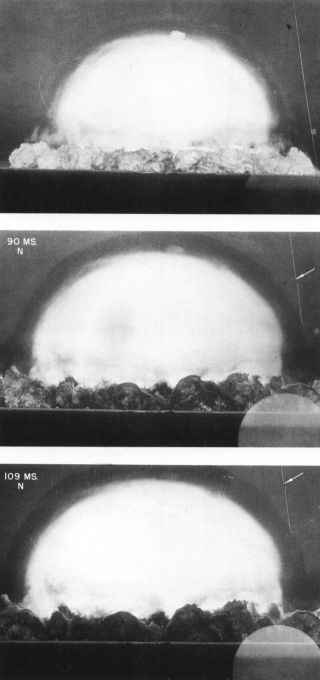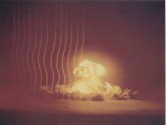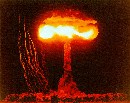
showing optical refraction at the shock front.
Click for larger view (190 k).





By Carey Sublette
Last changed 18 June 2002
 |
| Trinity between 90 and 109 milliseconds, showing optical refraction at the shock front. Click for larger view (190 k). |
The question I get asked most frequently about this web site is "What are those funny lines in those pictures of nuclear tests"? This page explains what those lines are, and why they are there.
In the first milliseconds after a nuclear explosion in the atmosphere, the rapidly growing fireball and shock wave of the explosion are one and the same. The surface of the expanding fireball is in fact the front of the shock wave.
Once the fireball cools to 300,000 degrees C (which is 15 milliseconds after detonation for a 20 kt explosion), the shock front and the fireball separate - a phenomenon called "breakaway". After that moment the shock front quickly becomes invisible as it loses strength and can no longer make air incandescent through compression heating.
This makes it difficult to record the progress of the shock front. Shock pressure gauges can be used, but they are difficult to deploy anywhere but near the ground where interactions between the shock wave and the surface complicate their interpretation.
A solution to this problem was suggested by a serendipitous observation in the very first nuclear test, the Trinity shot on 16 July 1945 (see at left). Berlyn Brixner photographed the cable of barrage balloon (the vertical white line at the left edge of the picture) behind the fireball which was visible due to the smoke from the vaporizing cable.
As the shock front passed in front of the cable, which was in the background, an apparent break appeared in the cable - an optical illusion caused by refraction of light by the compressed air behind the shock front. The arrow in the second and third pictures shows the movement of this break, which coincides with the location of the shock front.
Several years later this phenomenon was put to use with the aid of smoke rockets launched from the ground seconds before the detonation. This created an vertical array of reference lines against which the progress of the shock front could be photographed.
Not that it is not the actual direct interaction of the blast wave colliding with the smoke that is involved here.
The earliest picture I have in which the smoke rocket trails are visible is "Tumbler-Snapper Able on 1 April 1952.
Frank H. Shelton provides an account of this technique of nuclear test observation in the Upshot-Knothole Annie on 17 March 1953:
My attention was drawn to the role and functions of the Naval Ordnance Laboratory's rocket generated smoke trails that formed a vertical grid behind the burst point. Everett (Everett Cox - CS) explained to me that Greg Hartmann's NOL staff, in conjunction with the EG&G photography team, used the smoke trails to record the shock front as a function of space and time, from which they could calculate the shock velocity, which in turn, with the Rankine-Hugoniot conditions, gave the shock overpressure versus space around the burst."Aren't the smoke trials way in back of the detonation?" I queried. "And they didn;t appear to have beeen hot by the blast until quite late.?" "Thant's right," Cox elaborated, "the high density air immediately behind the shock front causes a refraction break in the apparent position of the smoke trails." I see, that's neat." "If you want to define the shock front conditions, however," I continued, "couldn't you also define the shock conditions on the interior of the blast wave by observing the compression of the smoke and also measuring the particle velocity?" "I guess so," responded Everett, but it sound pretty complicated to me."
Shelton, Frank H. 1988. Reflections of a Nuclear Weaponeer. Shelton Enterprise Inc. pp. 6-13 to 6-14.
Shelton goes on to relate that he did attempt to measure the shock wave in the Teapot HA test using the actual displacement of smoke puffs by the passage of the shock, but without much success.
 Upshot-Knothole Annie (331x250, 13 K) Upshot-Knothole Annie (331x250, 13 K) |
| Click here for bigger images |
Another Upshot-Knothole shot, Climax, showing smoke trails.
 Upshot-Knothole Climax
Upshot-Knothole Climax
Pick 651x519 (109 K) size, or 288x225 (21 K) size.